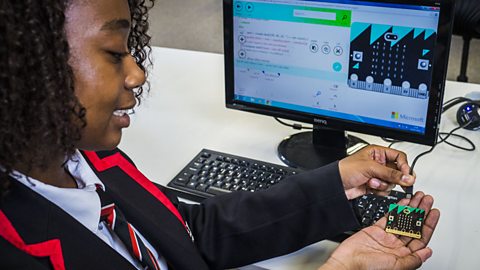The 大象传媒 micro:bit
**Head to to find out about the 大象传媒’s new micro:bit initiative**

What is the 大象传媒 micro:bit?
Meet the 大象传媒 micro:bit, a pocket-sized codeable computer.
The is a pocket-sized codeable computer with motion detection, a built-in compass and Bluetooth technology, which was given free to every child in year 7 or equivalent across the UK in 2016.
A collaboration between 29 partners, the 大象传媒 micro:bit is the 大象传媒's most ambitious education initiative in 30 years, with an ambition to inspire digital creativity and develop a new generation of tech pioneers.
The UK currently faces a critical skills shortage in the technology sector and the 大象传媒 and partners aim to help change that.
In the 1980s, the 大象传媒 Micro introduced many children to computing for the first time and the 大象传媒 micro:bit, part of the 大象传媒’s Make it Digital initiative, will build on the legacy of that project for the digital age.
It aims to inspire young people to get creative with digital and develop core skills in science, technology and engineering.
Coding in seconds
“We happily give children paint brushes when they’re young, with no experience - it should be exactly the same with technology," Sinead Rocks, Head of 大象传媒 Learning said.
"The 大象传媒 micro:bit is all about young people learning to express themselves digitally, and it’s their device to own.
"It’s our most ambitious education initiative for 30 years. And as the micro:bit is able to connect to everything from mobile phones to plant pots and Raspberry Pis, this could be for the internet-of-things what the 大象传媒 Micro was to the British gaming industry.”
It measures 4cm by 5cm, is available in a range of colours, and designed to be fun and easy to use. It can be coded with something simple in seconds – like lighting up its LEDs or displaying a pattern – with no prior knowledge of computing.
It also connects to other devices, sensors, kits and objects, and is a companion to Arduino, Galileo, Kano, littleBits and Raspberry Pi, acting as a spring board to more complex learning.
Each element is completely programmable via easy-to-use software on a dedicated website , that can be accessed from a PC, tablet or mobile.
A personal area on the website allows users to save and test creations in a simulator before they are transferred to the micro:bit, and the available tools scale to be as complex as ideas, imagination and skills require.

Key features of the micro:bit
• 25 red LEDs to light up, flash messages, create games and invent digital stories.
• Two programmable buttons activated when pressed. Use the micro:bit as a games controller. Pause or skip songs on a playlist.
• On-board motion detector or “accelerometer” that can detect movement and tell other devices you’re on the go. Featured actions include shake, tilt and freefall. Turn the micro:bit into a spirit level. Light it up when something is moved. Use it for motion-activated games.
• A built-in compass or “magnetometer” to sense which direction you’re facing, your movement in degrees, and where you are. Includes an in-built magnet, and can sense certain types of metal.
• Bluetooth Smart Technology to connect to the internet and interact with the world around you. Connect the micro:bit to other micro:bits, devices, kits, phones, tablets, cameras and everyday objects all around. Share creations or join forces to create multi-micro:bit masterpieces. Take a selfie. Pause a DVD or control your playlist.
• Five Input and Output (I/O) rings to connect the micro:bit to devices or sensors using crocodile clips or 4mm banana plugs. Use the micro:bit to send commands to and from the rings, to power devices like robots and motors.
First conceived by 大象传媒 Learning in 2012, and initially developed together with the 大象传媒’s award-winning R&D department, the scale and scope of this unique initiative has only been made possible by an unprecedented collaboration between 29 international organisations, pioneering start-ups and transformative education organisations.
One million micro:bits
The 大象传媒 is the overall editorial and project lead for the micro:bit, coordinating the partnership, micro:bit development and delivery, learning resources and on-air and online inspiration for teachers, schools and makers across the UK.
Product partners include:
• ARM - providing mbed hardware, software development kits and compiler services
• Barclays - supporting overall product delivery and outreach activities
• element14 - sourcing components and managing the manufacturing
• Freescale - supplying the sensors and USB controllers
• Lancaster University - created and wrote the micro:bit runtime
• Microsoft - providing the TouchDevelop web-based programming tools and hosting service as well as teacher training materials
• Nordic Semiconductor - supplying the main processor and enabled Bluetooth Smart
• Samsung – connecting the 大象传媒 micro:bit to phones and tablets, and developing the Android app
• ScienceScope - distributing to schools and developing the iOS App
• Technology Will Save Us - designed the shape, look and feel of the device
• The Wellcome Trust – Providing learning opportunities for teachers and schools
Product champions, who will help to support the device through outreach, engagement, educational resources and additional services include, Bluetooth SIG, Cannybots, Cisco, Code Club, Coderdojo, Code Kingdoms, Creative Digital Solutions, CultureTECH, Institution of Engineering and Technology, Kitronik, London Connected Learning Centre, MyMiniFactory, Python Software Foundation, STEMNET, TeenTech and the Tinder Foundation.
Fundamental to the success of the 大象传媒 micro:bit, the 大象传媒 and partners will be working closely with teachers, educators and schools to ensure that resources, information and support are available in advance of distribution this autumn. 大象传媒 Learning will also provide resources that support the curriculum including Live Lessons, getting started videos, projects and tutorials.
The technical specifications for the device will be open sourced, and the partnership plans to collectively develop a not-for-profit company to oversee and drive the micro:bit legacy.
